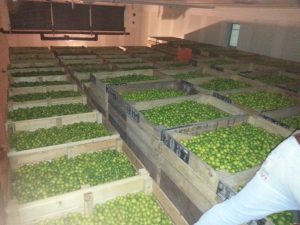What Food Can Be Stored in Cold Storage?
Introduction
When it comes to food storage, proper temperature control is crucial to maintaining freshness and preventing spoilage. Cold storage, also known as refrigeration, is a common method used to preserve various types of food. By keeping food at lower temperatures, the growth of bacteria and other microorganisms is slowed down, extending the shelf life of perishable items. In this article, we will explore different categories of food that can be safely stored in cold storage, ensuring their quality and safety.
1. Fresh Produce
Fruits
Refrigeration is an excellent way to store many types of fruits. However, not all fruits benefit from cold storage. Citrus fruits, such as oranges and lemons, can be stored in the refrigerator to maintain their freshness and prolong their shelf life. Apples, grapes, and berries are other examples of fruits that can be stored in cold storage. Remember to wash and dry them thoroughly before refrigerating to prevent moisture-related issues.
Vegetables
Just like fruits, certain vegetables can be safely stored in cold storage. Leafy greens, such as lettuce, spinach, and kale, can be stored in the refrigerator to maintain their crispness. Root vegetables like carrots, beets, and radishes also fare well in cold storage. It’s important to remove any excess moisture and store them in perforated bags or containers to prevent condensation and spoilage.
2. Dairy Products
Milk and Dairy Alternatives
Milk and dairy alternatives, such as almond milk or soy milk, should be stored in the refrigerator to keep them fresh. The cold temperature helps to slow down bacterial growth, ensuring the safety of these products. Make sure to check the expiration date and consume them before they spoil. Always keep milk containers tightly sealed to prevent absorption of other odors in the fridge.
Cheese
Cheese is another dairy product that benefits from cold storage. Hard and semi-hard cheeses like cheddar, Swiss, or Parmesan can be stored in the refrigerator to maintain their texture and prevent spoilage. It’s best to wrap them in wax paper or parchment paper before placing them in a resealable bag to retain their moisture levels.

3. Meat and Poultry
Fresh Meat
Fresh meat, including beef, pork, lamb, and poultry, should be stored in the refrigerator to prevent bacterial growth and maintain its quality. It is essential to store raw meat in sealed containers or wrap it tightly in plastic wrap or aluminum foil to prevent cross-contamination with other foods. Remember to keep meat products on the lower shelves of the fridge to prevent any drippings from contaminating other items.
Processed Meats
Processed meats, such as sausages, bacon, and deli meats, should also be stored in the refrigerator to maintain their freshness. These products have a shorter shelf life compared to fresh meat, so it’s important to check the expiration dates and consume them within the recommended time frame. Store them in airtight containers or wrap them tightly in plastic wrap to prevent moisture loss.
4. Seafood
Fresh Fish
Fresh fish and seafood, including salmon, trout, shrimp, and scallops, are highly perishable and require cold storage to maintain their quality. These items should be stored in the refrigerator at temperatures between 32°F (0°C) and 39°F (4°C). To prevent odor transfer, store seafood in tightly sealed containers or wrap them in plastic wrap before placing them in the refrigerator. It’s recommended to consume fresh fish and seafood within a day or two for the best taste and texture.
Frozen Seafood
If you have seafood that you won’t be able to consume within a day or two, freezing is an excellent option. Freezing seafood not only extends its shelf life but also helps maintain its quality. Wrap seafood tightly in freezer-safe packaging, such as plastic wrap or freezer bags, to prevent freezer burn. Make sure to label the packages with the date of freezing to keep track of their freshness. Frozen seafood can be stored in the freezer for several months, depending on the type of seafood.
5. Baked Goods
Bread
Bread is a staple in many households, and while it can be stored at room temperature for a few days, storing it in the refrigerator can help prolong its freshness. However, keep in mind that refrigeration can cause bread to stale faster. To mitigate this, store bread in airtight bags or containers to prevent moisture loss and maintain its softness.
Pastries and Cakes
Pastries and cakes that contain perishable ingredients, such as cream, custard, or fruit fillings, should be stored in the refrigerator. The cold temperature helps prevent the growth of bacteria and preserves the quality of these desserts. However, note that refrigeration can alter the texture of some pastries, making them slightly denser. Wrap them in plastic wrap or place them in airtight containers to prevent them from drying out.
6. Condiments and Sauces
Mayonnaise and Salad Dressings
Mayonnaise-based condiments, like mayonnaise itself and salad dressings, should be stored in the refrigerator. These products contain ingredients that can spoil at room temperature, making refrigeration necessary to maintain their freshness and safety. Always check the expiration dates and discard any expired or spoiled condiments. For insulated doors windows curtains see here.

Tomato-Based Sauces
Tomato-based sauces, such as pasta sauce or salsa, should be stored in the refrigerator after opening. The cold temperature helps prevent the growth of molds and bacteria. Transfer opened jars to airtight containers for storage and use them within a few days for optimal flavor.
Conclusion
Cold storage is an effective method to prolong the shelf life of various types of food. From fresh produce to dairy products, meat, seafood, baked goods, and condiments, many items can benefit from refrigeration. Proper storage practices, such as using airtight containers, wrapping food securely, and checking expiration dates, are essential for maintaining the quality and safety of refrigerated food. By following these guidelines, you can extend the freshness of your perishable items and reduce food waste, ensuring that you always have quality food available in your cold storage.

Recent Comments